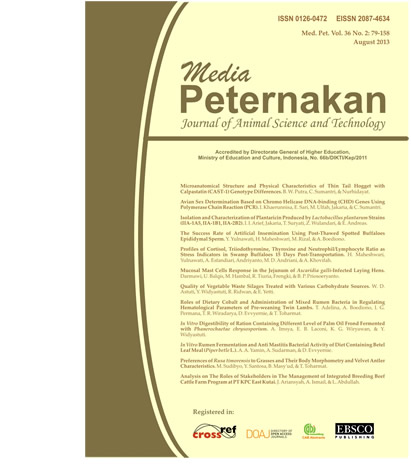In Vitro Digestibility of Ration Containing Different Level of Palm Oil Frond Fermented with Phanerochaetae chrysosporium
Abstract
Phanerochaete chrysosporium was widely used to delignify agricultural waste product and improve biodegradation of the substrate as animal feed. The experiment was carried out to increase the use of palm oil fronds as a substitute material for napier grass through biodegradation process with P. chysosporium. A completely randomized design with four treatments and four replications was used. The treatments were ration containing 60% napier grass (R1), ration containing 40% napier grass and 20% fermented palm oil frond (R2), ration containing 20% napier grass and 40% fermented palm oil frond (R3), ration containing 60% fermented palm oil frond (R4). Fourty percent concentrate was included in all treatment rations. Parameters measured were in vitro digestibilities of dry matter, organic matter, crude fiber, NDF, ADF, NH3, TVFA, and ruminal cellulolitic bacteria. Results showed that increasing level of fermented palm oil frond in the ration reduced (P<0.05) digestibilities of dry matter, organic matter, crude fiber, NDF, ADF, N-NH3, TVFA concentration and number of ruminal cellulolytic bacteria. It is concluded that fermentation of palm oil frondwith P. chysosporium decrease lignin content by 47.79%, but increasing the fermented palm oil frond in the ration reduces nutrient digestibilities, N-NH3 and TVFA concentrations and rumen cellulolytic bacteria counts. Fermented palm oil frond up to 40% could be used as a substitute for forages in ruminant rations.



